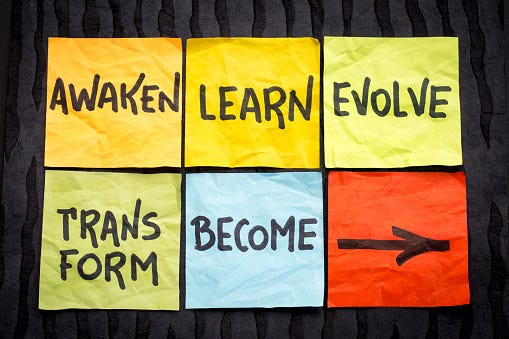The Best Way to Solve Problems
Basic innovative tips for creative decision-making
“This newsletter serves a demographic of highly intelligent readers, deep thinkers, life hackers, preppers, entrepreneurs, and survivalists. I especially focus on those with a passion for ideas, critical thinking, strategic game theory, and a desire to understand the world around them. Readers of my posts are usually tired of being patronized elsewhere by fact-less, opinionated know-nothings, misinformation, conspiracy theories, and fake news.
“Knowledge is power, wisdom brings meaning, contentment, and happiness!”
The Life Strategies Playbook & Mentoring Program is a reader-supported publication. To receive new posts and support my work, consider becoming a free or paid subscriber. (Sign up at the end of this newsletter)
———————————————————
———————————————————
On a personal note: Please excuse grammatical errors, typos, repetition, and any general nonsense, and such in this post. I am getting a bit older now, and I have about 20,000 pages of information that must get published before I leave the mortal coil. I simply write and publish more than my humble editors are able to correct. If you find enough errors you are welcome to contact me about being an editor of my work.
Thanks for sharing this newsletter with your friends and associates -
Join us for daily tips on personal development at our free Self-Improvement for Beginners Community and Forum on Facebook
Click Below or cut and paste the URL to Join
https://www.facebook.com/groups/455029215769173
——————————————————————————————————————
A 3 - Minute Read
As I explore self-improvement tips online it is clear that most people are not just looking for information but are looking for ways to solve problems. The most common questions asked are; What is problem-solving explain? What is problem-solving Wikipedia?...and Why is problem-solving important?
The answer to all of these questions is tied to innovative thinking.
Let me address both questions in today’s newsletter.
Throughout our lives, we are presented with obstacles that prevent us from doing what we want or need to do. Often, we do not recognize or even notice them because they are small or seem insignificant.
To understand thinking processes in relation to obstacles that must be addressed and problem-solving we must remember that for the extraordinary individual this is done in the service of creating a personal highly functional reality.
To do this we must understand the way words, language, and patterns define who we are, what we experience, how we experience it, and how we behave with others.
Anyone seeking to remove or respond effectively to obstacles and the problems that come from them must have a system of steps and mental and or physical tools to help them to initiate and implement a project.
When dealing with any but the most basic obstacles it is wise to work collaboratively with a support team of skilled critical thinkers and if needed, experts.
What follows are simple tips to help you effectively and organically solve problems in your life, and in your creative process.
“There would be times when we’d rack our brains on a user interface problem, and think we’d considered every option, and he would go, “ Did you think of this? “ said Fadell. “ And then we’d all go, “ Holy Shit.” He’d redefine the problem or approach, and our little problem would go away.”
― Walter Isaacson, Steve Jobs
When working collaboratively the first way to apply the system is to gain agreement on the problem. Next…
Gain agreement on the direction for a solution
Gain agreement that the solution removes the obstacle or creates a bottleneck for dealing with it.
Agree to overcome any potential negative ramifications (ripple effect) for removing or bottlenecking the obstacle.
Agree to overcome any factors that might block implementation.
Experts in the Theory of Obstacles sometimes refer to these in the negative as working through layers of resistance to a change.
As the great Taoist mystic Lao Tzu teaches, if small obstacles are not addressed early they may expand rapidly and become great. Like a small insect landing on a pond, the problem ripples outward and expands, creating greater complications.
Some obstacles are basic. An example would be changing a light bulb. Other obstacles are much more complex — losing your job while dealing with the illness of a loved one, just when a flood washes away your home for example.
Obstacles of greater complexity may have multiple premises that need to be addressed.
It is not enough to understand that the rate of goal achievement and peak performance in a goal-oriented g system is limited by at least one obstacle. It is also important to understand that any process will unfold in an organic and natural manner, limited only by the laws of physics if there is nothing preventing the system from achieving higher PEEPPASA (practicality, effectiveness, efficiency, precision, productivity, accuracy, and self-awareness).
Without some obstacle, the system’s potential would be infinite — which is impossible in a real-life system. To learn more about this idea you may wish to research the Theory of Incompleteness of Kurt Godel.
Only by increasing PEEPPASA - by going over, under, around, or through an obstacle - can we consistently solve problems.
The Takeaway
Assuming the goal of a system has been articulated and its measurements defined, the steps are:
Identify the system’s obstacle(s).
Decide how to overcome or at least exploit the system’s obstacle(s).
Subordinate everything else to the above decision(s).
Alleviate the system’s obstacle(s) if this is possible.
If in the previous steps an obstacle has been broken, go back to step 1, using a pattern language model to create new approaches to isolating and addressing the obstacle.
Warning: When applying step 5, do not allow inertia to cause a new system obstacle.
The five focusing steps aim to ensure ongoing improvement efforts are centered on the obstacle(s). In the TOO literature, this is referred to as the process of ongoing improvement (POOGI).
If you enjoyed this article we’ve got an article from last month that is connected to the one you read today. You can click here below the arrow to read that article.
.….and remember, life is not a dress rehearsal!
——————————————————————————————————————
Author: Hey there. My name is Lewis Harrison, and I am a transformational coach, teacher, and prepper. I am a proponent of entrepreneurism and also a writer and seminar leader. The author of over twenty books, and numerous self-improvement, business success, and personal development courses, I am the former host of a talk show on NPR Affiliated WIOX91.3 FM.
“I believe to be more effective, efficient, precise, productive, successful, and more self-aware we need a coach or mentor. I have always had coaches and mentors, usually more than one. If you are ready, willing, and able to give up your unnecessary struggle, consider contacting me about becoming your coach-mentor. We can begin with a fifteen-minute call to see what your needs and challenges are and how I can help you address them”.
———————————————————
The Course
I will soon be offering a 2 1/2 hour - five-part course on How to Find Happiness through the Best Self Improvement Tips. The tuition for the course is $47. Enrollment will begin in just a few days. The course will include tips on emotional healing, personal finance, simple living, and non-dogmatic spiritual practices. This low-cost, content-rich course will be fun, informational, motivational, and inspirational. Get ready for a life-changing experience!
Lewis
———————————————————
I can be contacted directly about the course, business and life coaching, and more advanced training in how to win the game of life, at LewisCoaches@gmail.com
To get regular tips, techniques, life hacks and prepper shortcuts join our Self Improvement for Beginners Facebook community of creators and innovators. It’s free. Click just below the arrow to join!
-Join my group of 18,000 influencers.








